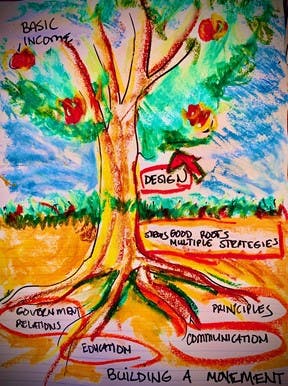At a recent Basic Income Calgary meeting the concept of a tree was used to illustrate what it takes to build a movement. Four members of the group share their insights on this concept.
Article
How do you move the basic income conversation forward?
Four members of Basic Income Calgary share their insights
10 March 2021

Building the basic income movement
Basic income is not a new idea, and yet sometimes building basic income groups across Canada can be a challenge. How do we move the conversation forward?

Building strong roots is critical if we want basic income to grow beyond just an idea
Building strong roots, below the surface
Building strong roots is critical if we want basic income to grow beyond just an idea. Community building is the most difficult work, as it happens below the ground. Having conversations that include diverse groups throughout our community can help answer questions like, “what does a principled basic income include?”
Collecting our experiences to build a forest of supports
Experiences of marginalization create a collective yearning for social change. Building a movement includes asking ourselves, “who is and who is not at the table and why not?” If we think of the organizing and advocacy work around basic income as one tree, it grows and thrives better, not in isolation, but with the collective strength and support of other trees, creating a forest of social causes.
Trees in a forest support each other through the connections and interactions of their roots . Resources are shared and even redirected to trees that require more care and nourishing. The civil rights movements in the 50s and the 60s brought with it a wave of interconnected social causes around peace, eradication of poverty, education reform, and yes - basic income. In the forest, trees support each other and communicate the ecology of their roots to help one another; if we are all rooted in our experiences and rooted in what our experiences mean for others, then there is good potential for connection to each other through our roots and connectedness.
Strengthening the roots of the movement
Learning and sharing diverse perspectives must include lived experiences. While these roles sound easy; a strong root base takes time. After a campaign, groups should ask, “has this increased our understanding, our capacity, or our numbers?”
As we see the world move towards more automated jobs, higher unemployment, addressing world pandemics, and overall greater income insecurity, continuing to nurture strong roots ensures the systems, that will eventually be designed, will work for everyone. A holistic communication strategy will ensure a principled basic income design that provides for a decent lifestyle and will enable full participation in the community.
Having strong roots grounded in principles and engaging with people of all political stripes, helps the movement grow beyond election cycles.
Moving up the tree too fast makes the tree fall over
It is common when a person is new to the movement that they may want to move right into design questions or growing the tree before the root system is in place. Questions like how much is it going to cost, who will be left out, and who will be included can divide and conquer a community and weaken efforts. While design questions are critical to consider as part of the conversation, there is a danger of building a strategy based on design questions far too early. The Dauphin Manitoba and Ontario pilots illustrate this concept. They were both ended early due to a change in government. If a new government has not been part of the conversation and is unfamiliar with an upstream approach to poverty reduction, it will be more difficult to get their “buy in.” Design questions have their place in conversations with all stakeholders; however, having strong roots grounded in principles and engaging with people of all political stripes, helps the movement grow beyond election cycles. Once you have non-partisan support, this will be the time when a specialized design team tackles the really hard questions and develops policy.
Mutual respect, mutual recognition and mutual stake in each other’s growth
Coalition building is a very important part of movement building. A very dear friend and colleague in the social movements in the Philippines who recently passed away, Clark Soriano, described some of the most important principles in coalition and movement building. He called these the 3Ms. One, mutual respect for each other as forces for change, even if we have differing emphasis or actions. Two, mutual recognition of each other's independence and autonomy, that we acknowledge each other's causes and issues and organizations. Three, mutual stake in each other's growth, that we benefit from the gains and strengths of each other's work. These principles can be practical guides for our actions and decisions.
Cesar Cala, Ben Patmore, Wendy Benson and Colleen Huston
Basic Income Calgary
Basic Income Calgary
Resources
- About Basic Income Calgary
- The Big Experience is a free tool to help you build the movement for basic income
- Ontario Basic Income Pilot
Related Articles
Fighting loneliness by tackling poverty
Stronger communities through adequate wages, housing, and transit

Newsletter
Get updates directly in your inbox on how poverty is changing in Calgary.


